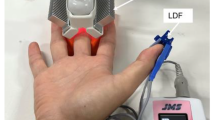Summary
This study was made to see whether changes in blood flow through the capillaries and arteriovenous anastomoses (AVA's) of the human finger can be measured by noninvasive flowmetry. Total finger blood flow (FBF) was measured by venous occlusion plethysmography; blood flow was measured by a laser-Doppler flowmeter (ADVANCE, ALF-2100, Tokyo, Japan) using probes with optic fiber separations of 0.3 mm (LDF-0.3) and 0.7 mm (LDF-0.7). The maximum sensitivities for LDF-0.3 and LDF-0.7 were at depths of 0.8 and 1.2 mm from the tissue surface respectively. Two series of experiments were performed on separate days. In the first series the test hand was immersed in a water bath whose temperature (Tw) was 25°C at an ambient temperature (Ta) of 25°C. Tw was raised to 35°C (local hand warming), which was then followed by an increase in Ta to 35°C (whole body warming). FBF, LDF-0.3, and LDF-0.7 increased during these thermal stimulations. However, the relationship of FBF to LDF-0.3 showed two different regression lines. In contrast, the relationship of FBF to LDF-0.7 showed a single regression line. In the second series, with Ta at 35°C, the test hand was immersed in a water bath at Tw 35°C. Tw was then raised every 10 min by 2°C steps from 35 to 41°C. At Tw 39–41°C, FBF and LDF-0.7 in the test hand were significantly decreased compared with those at Tw 35°C. In contrast, LDF-0.3 increased steadily as Tw rose from 35 to 41°C. These results suggest that laser-Doppler flowmetry, using flow probes with different optic fiber separations, can measure partitional blood flow through superficial vessels, predominantly capillaries, and deeper vessels, mainly AVA's, in the human finger.
Similar content being viewed by others
References
Bonner RF, Clem TR, Bowen PD, Bowman RL (1981) Laser-Doppler continuous real-time monitor of pulsatile and mean blood flow in tissue microcirculation. In: Chen SH, Chu B, Nossal R (eds) Scattering techniques applied to supramolecular and non-equilibrium system, NATO ASI Ser B, vol. 73. Plenum Publishers, New York, pp 685–702
Clara M (1956) Die arterio-venösen Anastomosen. (2. Aufl.) Springer, Wien, pp 12–23
Coffman JD, Cohen AS (1971) Total and capillary fingertip blood flow in Raynaud's phenomenon. N Eng J Med 285:259–263
Cronenwett JL, Zelenock GB, Whitehouse WM Jr, Stanley JC, Lindenauer SM (1983) The effect of sympathetic innervation on canine muscle and skin blood flow. Arch Surg 118:420–424
Grant RT, Bland EF (1931) Observations on ateriovenous anastomoses in human skin and in the bird's foot with special reference to the reaction to cold. Heart 15:381–411
Hales JRS, Fawcett AA, Bennett JW, Needham AD (1978) Thermal control of blood flow through capillaries and arteriovenous anastomoses in skin of sheep. Pflügers Arch 378:55–63
Hales JRS, Jessen C, Fawcett AA, King RB (1985) Skin AVA and capillary dilatation and constriction induced by local heating. Pflügers Arch 404:203–207
Hirata K, Nagasaka T, Hirai A, Hirashita M, Takahata T, Nunomura T (1986) Effects of human menstrual cycle on thermoregulatory vasodilation during exercise. Eur J Appl Physiol 54:559–565
Holloway GA Jr, Watkins DW (1977) Laser Doppler measurement of cutaneous blood flow. J Invest Dermatol 69:306–309
Honda N (1962) Temperature compensation for mercury strain gauge used in plethysmography. J Appl Physiol 17:572–574
Molyneux GS, Bryden MM (1981) Comparative aspects of arteriovenous anastomoses. In: Harrison RJ, Holmes RL (eds) Progress in anatomy. Cambridge University Press, pp 207–227
Nagasaka T, Cabanac M, Hirata K, Nunomura T (1986) Heat-induced vasoconstriction in the fingers: a mechanism for reducing heat gain through the hand heated locally. Pflügers Arch 407:71–75
Nagasaka T, Hirata K, Nunomura T (1987a) Contribution of arteriovenous anastomoses to vasoconstriction induced by local heating of the human finger. Jpn J Physiol 37:427–433
Nagasaka T, Hirata K, Nunomura T, Cabanac M (1987b) The effect of local heating on blood flow in the finger and the forearm skin. Can J Physiol Pharmacol 65:1329–1332
Nagasaka T, Cabanac M, Hirata K, Nunomura T (1987c) Control of local heat gain by vasomotor response of the hand. J Appl Physiol 63:1335–1338
Nelms JD (1963) Functional anatomy of skin related to temperature regulation. Fed Proc 22:933–936
Nilsson GE, Tenland T, Öberg PA (1980) Evaluation of a laser Doppler flowmeter for measurement of tissue blood flow. IEEE Trans Bio-Med Eng (vol BME-27) 597–604
Öberg PA, Nilsson GE, Tenland T, Holström A, Lewis DH (1979) Use of a new laser Doppler flowmeter for measurement of capillary blood flow in skeletal muscle after bullet wounding. Acta Chir Sand [Suppl] 489:145–150
Shepherd JT (1963) Physiology of the circulation in human limbs in health and disease. W. B. Saunders Co, Philadelphia, pp 9–72
Sherman JL (1963) Normal arteriovenous anastomoses. Medicine (Baltimore) 42:247–267
Sparks HV (1978) Skin and muscle. In: Johnson PC (ed) Peripheral circulation, John Wiley & Sons, New York, pp 193–230
Whitney RJ (1953) The measurement of volume changes in human limbs. J Physiol (Lond) 121:1–27
Author information
Authors and Affiliations
Rights and permissions
About this article
Cite this article
Hirata, K., Nagasaka, T. & Noda, Y. Partitional measurement of capillary and arteriovenous anastomotic blood flow in the human finger by laser-Doppler-flowmeter. Europ. J. Appl. Physiol. 57, 616–621 (1988). https://doi.org/10.1007/BF00418472
Accepted:
Issue Date:
DOI: https://doi.org/10.1007/BF00418472



